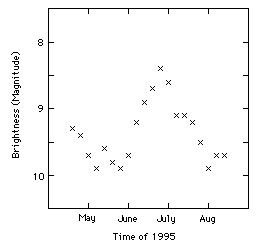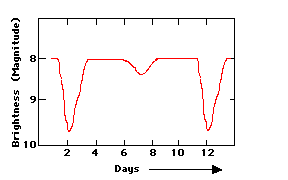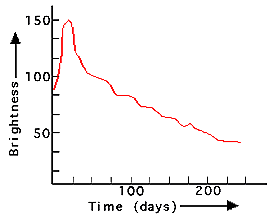Light Curves and What They Can Tell Us
Light Curves and What They Can Tell Us
Images show a scientist where in an object light is emitted. Another piece of information we have about light is when it reaches the detector. Astronomers use this "timing" information to create light curves and perform timing analysis.
![]() Tell me more about the history of timing in astronomy
Tell me more about the history of timing in astronomy
Light curves are graphs that show the brightness of an object over a period of time. In the study of objects which change their brightness over time, such as novae, supernovae, and variable stars, the light curve is a simple but valuable tool to a scientist.
This video compares the X-ray 'heartbeats', or light curves, of GRS 1915 and IGR J17091, two black holes that ingest gas from companion stars. (Credit: NASA's Goddard Space Flight Center)
If we had the following information about a particular source:
| Date |
Brightness (Magnitude) |
Date |
Brightness (Magnitude) |
| April 21 | 9.2 | June 20 | 8.7 |
| April 27 | 9.3 | June 26 | 8.3 |
| May 3 | 9.7 | July 2 | 8.6 |
| May 9 | 9.9 | July 8 | 9.1 |
| May 15 | 9.6 | July 14 | 9.1 |
| May 21 | 9.8 | July 20 | 9.2 |
| May 27 | 9.9 | July 26 | 9.5 |
| June 2 | 9.7 | Aug 1 | 9.9 |
| June 8 | 9.1 | Aug 7 | 9.7 |
| June 14 | 8.8 | Aug 13 | 9.7 |
then we might make a light curve, and it would look like this:

A simple light curve made from the data in the table above
The plot shows the brightness of a certain astronomical object viewed through a telescope every 6 days over the course of a few months. This gives us a light curve of the object we have measured. But light curves can be generated for any measure of brightness which is measured over time. So, if we measured the number of X-rays being emitted by a star during every second for an hour, we could generate a light curve from our observations.
What can we learn from light curves?
The record of changes in brightness that a light curve provides can help astronomers understand processes at work within the object they are studying and identify specific categories (or classes) of stellar events. We know generally what light curves look like for a set of objects, so when we plot a new light curve, we can compare it to those standard light curves to possibly identify the type of object we're observing.
If the light curve we measured looked like the graph below, we would identify the object as an eclipsing binary star. The light curve also shows us that it takes 10 days for one of the stars in the binary to orbit completely around the other. Astronomers would say that the binary system has an orbital period of 10 days.

Light curve of an eclipsing binary system
If, instead, the light curve we measured looked like the one below, we would know that this object was the death of a star by a massive explosion called a supernova!

Light curve of a supernova
Updated: August 2013

